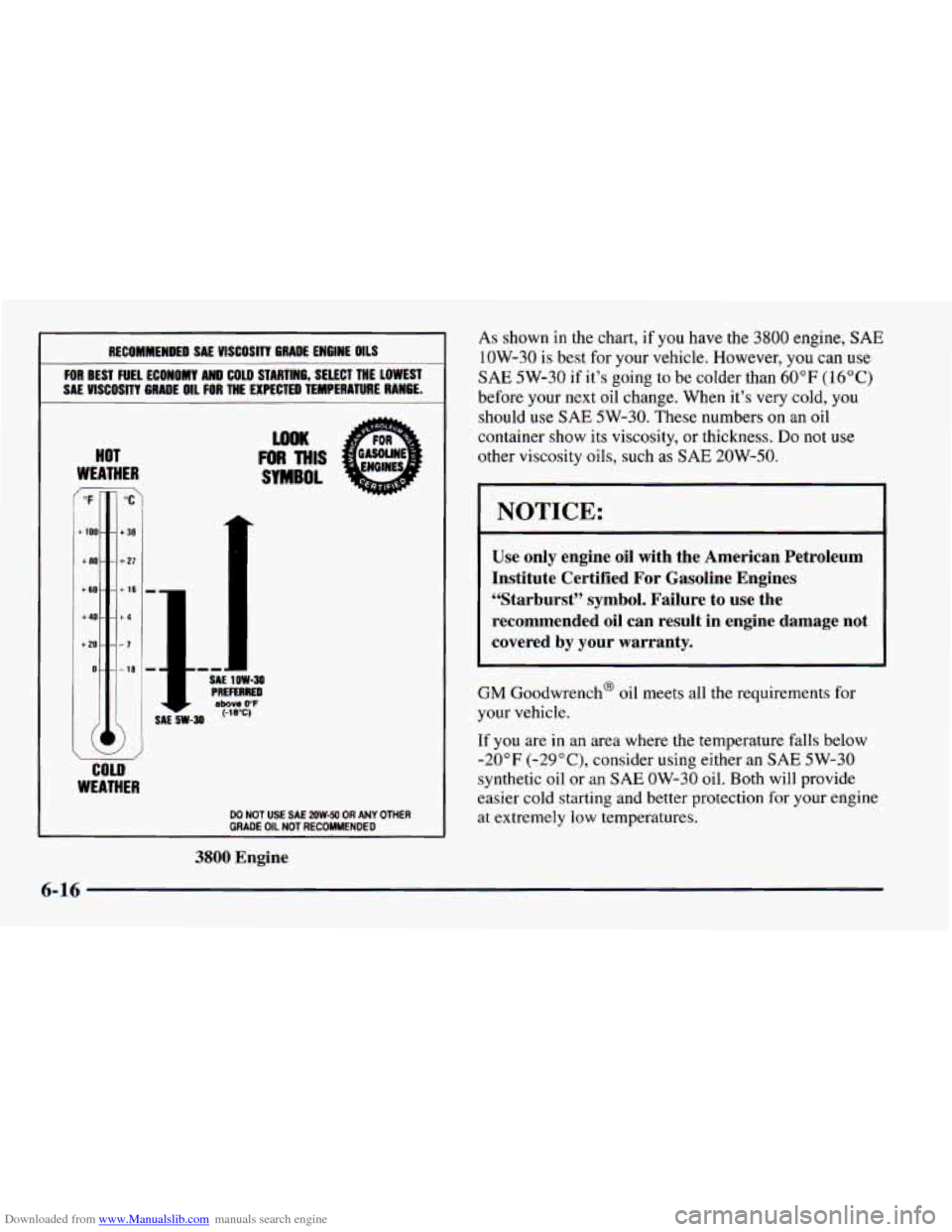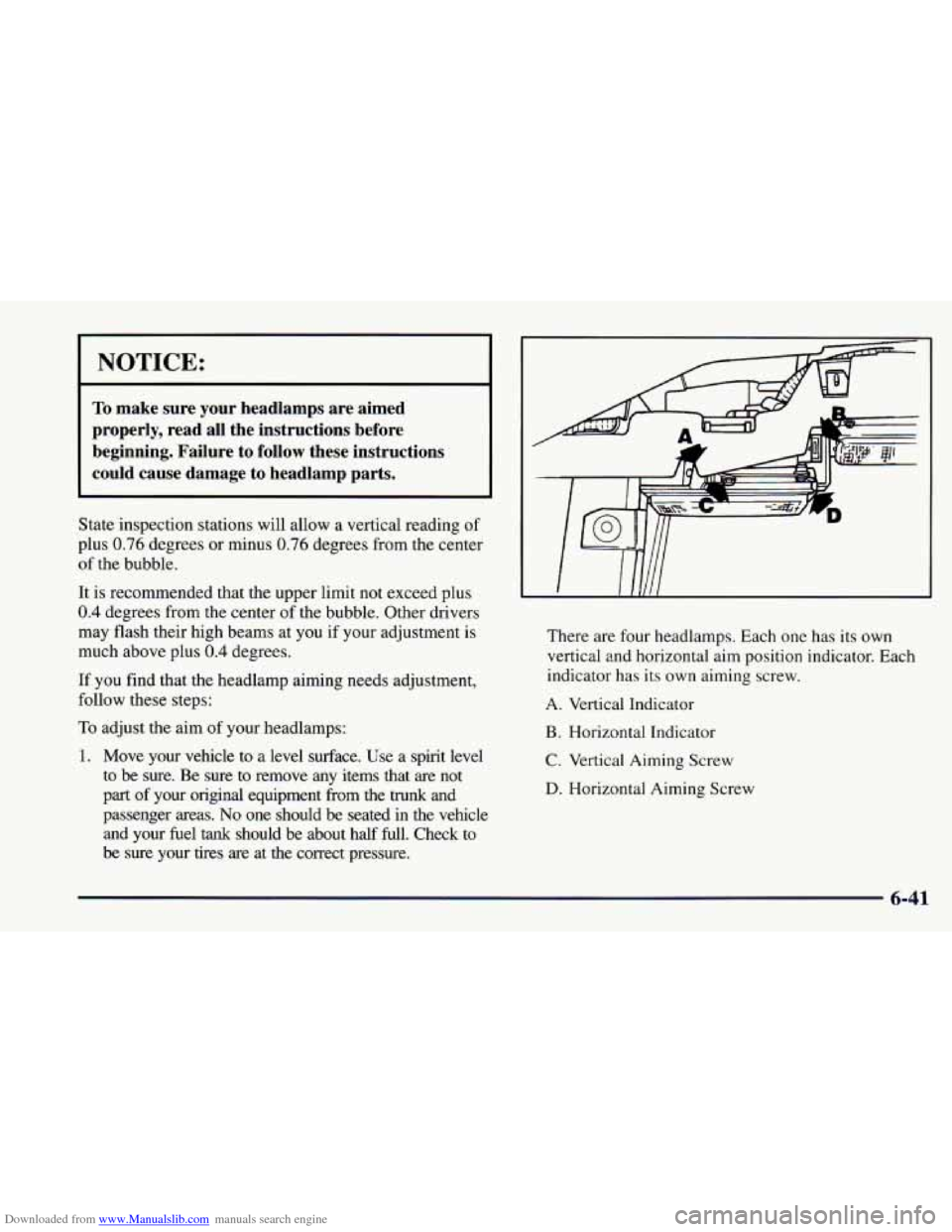Page 258 of 404
Downloaded from www.Manualslib.com manuals search engine Before closing the hood, be sure all the filler caps
are on.
Then just pull the hood down and close it firmly.
Engine Oil
If the LOW OIL light
on the instrument panel
comes on, it means you
need
to check your engine
oil level right away.
LOW OIL
For more information, see “Low Oil Light” in the Index.
You should check your engine oil level regularly; this is
an added reminder.
It’s a good idea
to check your engine oil every time you
get fuel. In order
to get an accurate reading, the oil must
be warm and the vehicle must be on level ground.
3800 Engine Oil Dipstick
The engine oil dipstick is the yellow loop near the back
of the engine
6-12
Page 261 of 404
Downloaded from www.Manualslib.com manuals search engine RECOMMENDED SAE VISCOSITY GRADE ENGINE OILS
FOR BEST FUEL ECONOMY AND COLD STARTING, SELECT THE LOWEST
SAE
VISCOSITY GRADE 011 FOR THE EXPECTED TEMPERATURE RANGE.
HOT
WEATHER
WOK
FOR THIS
SYMBOL
"F
+ 100-
+ 80 -
+ 60 -
+40-
+ 20 -
0-
\I
SAE SW-M PREFERRED
I SAE I law-30
COLD
WEATHER
DO NOT USE SAE 2OW-50 OR ANY OTHER
GRADE OIL NOT RECOMMENDED
5.7L Engine
As shown in the chart, if you have the 5.7L engine,
SAE 5W-30 is best for your vehicle. However, you can
use SAE 1OW-30 if it's going to be 0°F (-18°C) or
above. These numbers on an oil container show its
viscosity, or thickness.
Do not use other viscosity oils,
such as
SAE 20W-50.
6-15
Page 262 of 404

Downloaded from www.Manualslib.com manuals search engine RECOMMENDED SAE VlSCOSlTT GRADE ENGINE OILS
FOR BEST FUEL ECONOMY AND COLD STARTING, SELECT THE LOWEST
SAE VISCOSITY GRADE
OIL FOR THE EXPECTED TEMPERATURE RANGE.
HOT
WEATHER
WOK
FOR MIS
SYMBOL
wi
COLD
WEATHER
DO NOT USE SA€ 2OW-50 OR ANY OTHER GRADE OIL NOT RECOMMENDED
3800 Engine
As shown in the chart, if you have the 3800 engine, SAE
1OW-30 is best for your vehicle. However, you can use
SAE 5W-30 if it’s going to be colder than 60°F (16°C)
before your next oil change. When it’s very cold, you
should use
SAE 5W-30. These numbers on an oil
container show its viscosity,
or thickness. Do not use
other viscosity oils, such as SAE 20W-50.
NOTICE:
Use only engine oil with the American Petroleum
Institute Certified For Gasoline Engines “Starburst” symbol. Failure to use the
recommended oil can result in engine damage not
covered by your warranty.
GM Goodwrench@ oil meets all the requirements for
your vehicle.
If you are in an area where the temperature falls below
-20°F (-29”C), consider using either an SAE 5W-30
synthetic oil or an
SAE OW-30 oil. Both will provide
easier cold starting and better protection for your engine
at extremely low temperatures.
6-16
Page 287 of 404

Downloaded from www.Manualslib.com manuals search engine I NOTICE:
To make sure your headlamps are aimed
properly, read all the instructions before
beginning. Failure to follow these instructions
could cause damage
to headlamp parts.
State inspection stations will allow a vertical reading of
plus 0.76 degrees or minus 0.76 degrees from the center
of the bubble.
It
is recommended that the upper limit not exceed plus
0.4 degrees from the center of the bubble. Other drivers
may flash their high beams at
you if your adjustment is
much above plus
0.4 degrees.
If you find that the headlamp aiming needs adjustment,
follow these steps:
To adjust the aim of your headlamps:
1. Move your vehicle to a level surface. Use a spirit level
to be sure. Be sure to remove any items that
are not
part of your original equipment from the trunk and
passenger areas. No one should be seated in the vehicle
and
your fuel tank should be about half full. Check to
be sure your tires are at the correct pressure. There are four
headlamps. Each one has its own
vertical and horizontal aim position indicator. Each
indicator has its own aiming screw.
A. Vertical Indicator
B. Horizontal Indicator
C. Vertical Aiming Screw
D. Horizontal Aiming Screw
6-41
Page 297 of 404

Downloaded from www.Manualslib.com manuals search engine Inflation -- Tire Pressure
The Tire-Loading Information label, which is on the
driver’s door shows the correct inflation pressures
for
your tires when they’re cold. “Cold” means your vehicle
has been sitting for
at least three hours or driven no
more than 1 mile
(1.6 km).
If you’ll be driving at speeds higher than 100 mph
(160 km/h) where it is legal, raise the cold inflation
pressure
of each tire to 35 psi (240 kPa). When you
end this very high-speed driving, reduce the cold
inflation pressures to those listed on the Tire-Loading
Information label.
NOTICE:
Don’t let anyone tell you that underinflation or
overinflation is all right.
It’s not. If your tires
don’t have enough air (underinflation), you can
get the following:
NOTICE: (Continued) NOTICE:
(Continued)
Too much flexing
Too much heat
Tire overloading
Bad wear
Bad handling
0 Bad fuel economy.
If your tires have too much air (overinflation),
you can get the following:
Unusual wear
0 Bad handling
Rough ride
Needless damage from road hazards.
When to Check
Check your tires once a month or more.
Don’t forget your compact spare tire. It should be at
60 psi (420 kPa).
6-51
Page 312 of 404

Downloaded from www.Manualslib.com manuals search engine Finish Damage
Any stone chips, fractures or deep scratches in the finish
should be repaired right away. Bare metal will corrode
quickly and may develop into a major repair expense.
Minor chips and scratches can be repaired with touch-up
materials available from your dealer or other service
outlets. Larger areas of finish damage can be corrected
in your dealer’s body and paint shop.
Underbody Maintenance
Chemicals used for ice and snow removal and dust
control can collect on the underbody.
If these are not
removed, accelerated corrosion (rust) can occur on
the underbody
parts such as fuel lines, frame, floor
pan and exhaust system even though they have
corrosion protection.
At least every spring, flush these materials from the
underbody with plain water. Clean any areas where mud
and other debris can collect.
Dirt packed in closed areas
of the frame should be loosened before being flushed.
Your dealer or an underbody car washing system can do
this for you.
Chemical Paint Spotting
Some weather and atmospheric conditions can create a
chemical fallout. Airborne pollutants can fall upon and attack painted surfaces on your vehicle. This damage
can take two forms: blotchy, ringlet-shaped
discolorations, and small irregular dark spots etched into
the paint surface.
Although no defect
in the paint job causes this,
Chevrolet will repair, at no charge to the owner, the
surfaces
of new vehicles damaged by this fallout
condition within
12 months or 12,000 miles (20 000 km)
of purchase, whichever occurs first.
6-66
Page 316 of 404
Downloaded from www.Manualslib.com manuals search engine Main Fuse Block ~
FUSE USAGE CHART
10 20 30 40 STOPlHAZARD TURN 6-U PCM BATT RADIO ACCY 1
TAIL LTS HVAC 70 80 1 PWR ACCY COURTESY
9n lin 121]
LFI 130 140 ~-l 150
GAGES AIR BAG CIGAR/ACCY DEFOGEEATS
IGN PCM IGN WlPERlWASH BATT WINDOWS
IP DIMMER ACCY RADIO
SEE OWNER'S MANUAL FOR MORE INFORMATION PRINTED IN U.S.A 10281550 I
Fuse
STOPMAZARD
TURN
B-U
PCM BATT
RADIO ACCY
Usage
Hazard Flasher, Brake Switch
Assembly
Traction ControV2nd Gear Start
Switch, Back-up
Lamp Switch,
Turn Flasher, Daytime Running
Lamps (DRL) Module
Powertrain Control Module
(PCM), Fuel Pump Relay
Delco Audyssey Radio Amplifier
Remote CD player (trunk)
6-70
Page 319 of 404
Downloaded from www.Manualslib.com manuals search engine Fuse
HORN
INJECTOR
ENG SEN IGNITION
A/C-CRUISE
Usage
Horn Relay
Fuel Injectors
Mass Air Flow, Heated Oxygen
Sensor, Reverse Lockout
Solenoid, Skip Shift Solenoid,
Automatic Transmission,
Brake Switch
V6 VIN K: Electronic Ignition
Control Module
V8 VIN P: Ignition Coil Module,
Crankshaft Position Sensor
Air Conditioning Compressor
Relay; Cruise Control Switches
and Module
Relay
B
C
D
E
F
G
H
J
Usage
Air Conditioning Compressor
Anti-Lock Brake
Systeflraction Control
System (ASR)
Cooling Fan
1
AIR Pump
Cooling Fan
2
Not Used
Fog Lamps
Cooling Fan
3
6-73